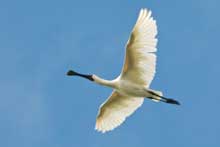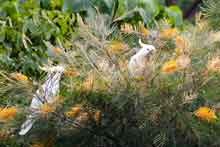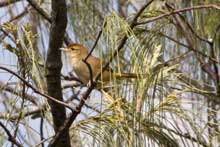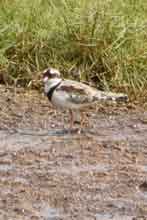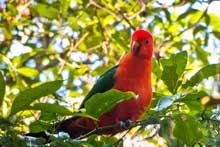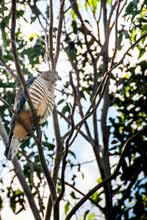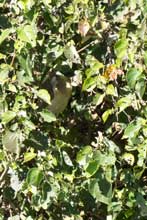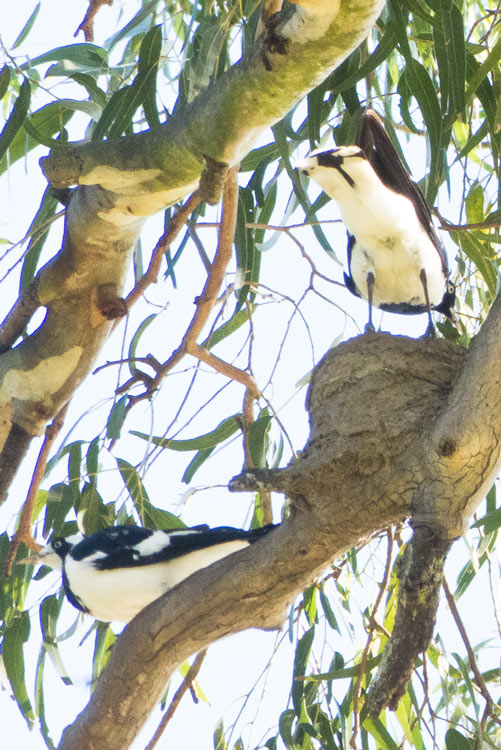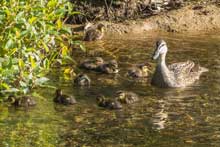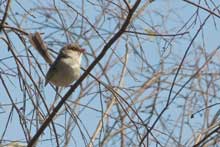Links to Home and to other years
General details of 2013 observations
Detailed results for 2013
Summary of results of past walks
Contact
Background
Since 2008, at least ten bird walks have been conducted each year in locations selected as being representative of bird habitats along Kedron Brook. This project aims to accumulate data on bird life along the Brook; specifically those variations in birds species noted together with their distribution.
To useful links and results from other years
Details of 2013 observations to date
Details of the locations and general arrangements for each walk are available in the yearly programs. Link to the 2013 Program here.
Nundah Cemetery, Albert Bishop Park, Shultz Canal, Nundah Lake - 3 February 2013
Six birders met at Nundah Cemetery (Zion Hill Bushcare Group’s area) on a fine cool morning at 7 am. The ground was sodden after the area had been drenched due to the heavy Australia Day weekend rains (ex tropical cyclone Oswald). However, a good list of 55 species was attained although prospects initially appeared bleak.
Some of the group were fortunate to sight a Striated Heron making its way up Schultz’ Canal which was exciting as was the later sighting of the Black -fronted Dotterel on a sand bank in the same area. It was interesting too, to see a group of House Sparrows sitting on a wire near the cemetery as these are seldom seen in numbers these days.
After moving to the Nundah Lake area, we were rewarded with a sighting of a Great Cormorant and a Collared Sparrowhawk. Tawny Grass Birds and Golden-headed Cisticola were also seen in the long grasses towards the lake.
Nundah Waterhole Reserve, Kedron Brook Floodway and Nudgee Beach - 3 February 2013
Extreme wet weather hampered our original survey date on Sunday March 3rd, so the alternative of Saturday March 9th was chosen.
The weather was initially quite threatening, though held the slim promise of fining up. In fact, only one rain storm at the water hole was experienced, the rest of the morning being cloudy with some sunny breaks. An excellent total of 48 birds were observed despite our earlier misgivings due to the weather. The track around the water hole was flooded and thus, only about half the track was traversed before we had to turn around and return to the starting point. Two Grey Shrike-Thrush were watched for several minutes as they caught grubs and devoured them in nearby trees. Their lovely clear calls resonated through the bush delighting us all. At the waterhole we saw Dusky Moorhens with chicks (very cute) and the Australian Grebes were very busy at play (courtship?).
At the boat ramp car park a small flock of crested Tern were seen; several were young/immature. There were also Silver Gulls, Little Black Cormorants and Pelicans sharing a rocky patch just above the high tide mark. We sighted Whistling Kites, a Brahminy Kite and a Royal Spoonbill flying overhead during this stop.
We proceeded to the beach without expecting to see much, but after a short stroll along the waters edge discovered Australian White and Straw-necked Ibis, a Mangrove Gerygone calling and a Tawny Grassbird sitting in a nearby tree to the delight of the photographer in the group.
Grinstead Park and Sparkes Hill Reserve - 7 April 2013
Eight observers met in the car park at Grinstead Park on a very overcast morning after a week of fairly consistent rain. Conditions were quite difficult as the birds are hard to see under these conditions. Even so, a respectable total of 38 species was observed.
There were quite a lot of Australian Figbirds, seen firstly in a large flock flying and swooping over head, and later, a large number were seen in nearby trees. Two young Olive-backed Oriels were sighted – a good result considering how quiet they were in the overcast conditions.
On Sparkes Hill, the familiar ‘pit-tchu’ call was heard and then a pair of Pacific Bazzas was sighted circling overhead.
Bellbird Grove Parkland - 5 May 2013 (7.30 am)
It was a fine cool morning, with some large clouds around, keeping much of the bushland in shade. However, some very interesting sightings were made, including that of Rose Robins - both male and females in separate locations, and a Shining Bronze Cuckoo and some Fan-tailed Cuckoos. We heard a Little Shrike Thrush which then posed on a nearby branch giving us all a good view (a first sighting for this area). A Restless Flycatcher was clearly heard later but kept hiding in the scrub. A Collared Sparrowhawk caused a massive disturbance but then, all returned to quiet once it passed over. The Whistlers were very active and gave brilliant displays; both the Golden and the Rufous. Forty-three species observed on this day made for a very interesting mornings walk.
Kedron Brook Wetlands - 5 May 2013 (Started 11.30 am)
Following our Bellbird Grove walk in the morning, we motored and then walked across to these wetlands to be viewed north-westwards from the bikeway leading north-eastwards beside the Kedron Brook Floodway. (See UBD map141 ref F1, almost on top of the bike symbol on this map!) We wanted to see if we could find some Freckled Ducks that had been reported to be in the wetlands there. No such luck - however, we were still well rewarded by the multiplicity of water birds and a total of six varieties of raptor! It wasn't a surprise that no one complained when, in less than two hours, forty-three species were sighted, making this a very rewarding outing.
This part of the wetlands is not an area we normally include in our programmed walks because of its relative dryness through the year. We tend to look mainly at the more distant Nundah Lake because it rarely fails to have some shorebirds taking advantage of its reliable resting area. (Nundah Lake can be accessed from a suitable viewing point on the roundabout for the Nundah access to the Gateway Motorway.) Due to the increased rainfall in the early part of this year, the area of this water in the wetland expanded from Nundah Lake almost to the Bikeway along the Floodway which, of course, attracted an increase of water birds in the area.
Wahminda Grove - 2 June 2013 (7.30 am till 9.30 am) Maureen Lawrence Park - 3 June 2013 ( 9.30 am till 11.00 am)
Due to time constraints, the survey this month was carried out over two mornings but still within the normal sequence and time adjustment. On Sunday morning, fine, cool and often cloudy, forty-one species were observed in the Wahminda Park-Wahminda Grove area. Of special interest was the sighting of the Rose Robins, the Eastern Yellow Robins and a most obliging Olive-backed Oriole which posed for the photographer in our group. Our small group enjoyed the company and the local knowledge of Ann Ellerman and Thierry Tomczak; both from Wahminda Grove Bushcare Group. Thierry is also the Leader for the local Joey Scout Group.
Monday morning dawned clear, quite cool but with blue skies and sunshine so Maureen Laurence Park was really alive with bird life. A Pacific Baza upset the Noisy Miners and they were very voluble in their protest. A number of the ' little' birds were sighted, due in part to the hour of the day and the sunny conditions. These included the White-throated Treecreeper, the Superb and Variegated Fairy- wrens, Red-browed Finches and a White-browed Scrubwren. A total of fifty species were noted for the combined survey obtained over the two successive days.
Cedar Creek, Upper Kedron - 7 July 2013 (7.30 am)
We met in Upper Kedron Road on a fine, somewhat 'Kool', morning. There was broken cloud, a weak sun and a coolish breeze. A total of fifty-two species was observed including a Black Kite. Although not uncommon for the area, this bird was a new species to be recorded within our six years program of surveys along our brook. An excellent sighting of a Pacific Baza was also obtained when it flew into a tree near the bridge at the top of our walk. This bird most obligingly posed for our photographer for quite a while before it flew further into the leafy top of another tree.
Of special interest was the opportunity of being able to see all three varieties of Fairy-wrens close together. The Striated Pardalotes were also very active and in good numbers. During this morning, the members of our small group were particularly keen and very observant. This greatly assisted our leader, Dawn Muir, and ensured a great 'bag' of birds were spotted on this most enjoyable birding walk.
Albert Bishop Park and Kedron Brook Wetlands (Nundah Lake) - 21 July 2013 (Birds Queensland birding program)
This Birds Queensland birding program outing was blessed with blue sky and sunshine and the eyes of eighteen keen birders. The walk commenced at the Nundah Cemetery at 7.30 am. There was the usual interest generated by the aged memorials as we progressed through the cemetery - an interesting part of Brisbane's early history.We progressed through to enjoy lovely sightings of Scarlet Honeyeaters, Blue-faced Honeyeaters and both the Noisy and Little Friarbirds. We followed the tree line along the side of this park then went onto the bikeway down the Schultz Canal. As this bikeway can be fairly busy, great caution was needed until we passed underneath the Southern Cross Motorway and could turn off onto a newly surfaced walkway which led to the wetland lake. We saw great activity along this path, with Golden-headed Cisticolas and Tawny Grassbirds on one side, and Grey Fantails, a Chestnut-breasted Mannikin and a Mangrove Gerygone on the other.
Although our group covered similar areas to those we saw on the walk on 2 February 2013, the previous use of cars to get over to Nundah Lake was unnecessary . Instead, we made pedestrian use of a new path from the bikeway ( UBD map 141 about ref D3) across to the Kedron Brook Wetlands associated with Nundah Lake (ref E1). The water level of these wetlands was no longer that experienced just after the full flood of six weeks ago but there was still considerable lake area for birds. Interesting observations included a flock of some fifteen plus Glossy Ibis, a White Necked Heron, Great and Little Egrets, a Royal Spoonbill and a Black Swan, amongst others. Five different raptors added to the excitement of the day, namely a White-bellied Sea Eagle, a Whistling Kite, a Brahminy Kite, a Spotted Harrier and a Swamp Harrier. In total, our group recorded a total of seventy-two species including four clearly heard but not directly observed.
Kalinga Park, Cressey Street Wetlands and Benelong Park - 8 August 2013 (7.30 am)
Sunday dawned fine but quite cold so we soon welcomed the sunny walk up the brook through to Cressy St Wetlands. Quite a few of the common parkland birds, such as Laughing Kookaburras and Black-faced Cuckoo-Shrikes were not observed but we were well rewarded with a few surprises. Firstly, in the trees next to the carpark we saw a large number of Scaly-breasted Lorikeets, including two pairs in nesting hollows. Looking up after a loud ruckus from the Noisy Minors, we watched a Grey Goshawk fly overhead. Not uncommon... but a great clear sighting.
We were fortunate to sight a Pale-vented Bush-hen near Walsh Park. It worked its way along in the rubbishy vegetation before disappearing into deeper cover. At the Cressy St Wetlands area, we saw some Hardheads; a first time sighting of this species along the Brook during these progammed walks. Also a first time sighting was that of a Nankeen Night-Heron sitting at the edge of the vegetation near the Toombul Terrace footbridge of Kalinga Park. We were extremely fortunate to get a photograph of this shy bird. Forty-three species... a most enjoyable outing.
Pony Club Bend and Teralba Park - 1 September (7.30 am)
Eight of us met on Fathers Day at Pony Club Bend on a fine warm morning. We enjoyed having Helen Moriarty there to talk about the ’Tuesday Tree Liberators’ and their neighbours, the Osborne Road bushcare group and their achievements – which we could see was quite extensive. She advised that a family of quail had visited them for morning tea recently and that she had also seen a widely reported Wompoo Pigeon making its way up the creek.
There was a good sized flock of Scaly-breasted Lorikeets observed – about ten or more flying across the creek. We were later entertained by the antics of a family of Pale-headed Rosellas as they swooped and called to each other back and forth across the creek.
A total of thirty-six birds were observed during this walk: the highlight being the mother Pacific Black Duck taking her nine recently-hatched ducklings on an exploration of their environment. Sadly, we didn’t see any quail or the Wompoo Pigeon, but it was good to hear about them nonetheless.
Grange Forest Park - 13 October (7 am)
The weather was fine and sunny. In just over two hours, thirty-nine species were observed. It was gratifying to note a rewarding number of small birds in the area; namely Scarlet Honeyeaters, Striated Pardalote, Brown Honeyeater, Red-backed Fairy-wren, Red-browed and Double-barred Finches, Chestnut-breasted Mannikin and White-browed Scrubwrens. We were particularly fortunate to see the nest of the Scrubwrens.
A bit later, hearing a great loud screeching, we observed a pair of Channel-billed Cuckoos enticing a pair of Pied Currawong to chase them. Although we did not actually see the female Channel-bill dart into the nest to lay her egg, it was certainly very loud and dramatic to watch them swoop and fly over the tree tops.
A Shining Bronze-Cuckoo left the protection of leafy shade to give us an excellent view of its iridescent feathers. Rainbow Bee-eaters also gave a brilliant display of their colourful wings as they swooped and dived, catching insects on the wing. At one point, a cacophony of bird alarm calls caused us to look up into the sky where a Brown Goshawk was flying high, following along the creek.
Cassimaty, Thomsett and Arbor Parks, Ferny Grove - 03 November (7 am)
A real spring morning with mostly a stroll under tree cover so, quite pleasant. Our first real interest was with the three White-breasted Woodswallows seen sitting on the electricity wires in front of the BP station. Very smart uniforms they wore. Then, the walk to Thomsett Park produced a group of curious Red-backed Fairy-wrens followed by a single Buff-banded Rail in the shadows next to the stormwater quality improvement device pond at Thomsett Park. A Dusky Morehen peeped out of a leafy nest and it's mate popped up on the nearby fence to see if all was well.
Not too much magic after that; a group of Noisy Friarbirds, a White-Browed Scrubwren and a pair of Black-faced Cuckoo-shrikes were found towards the golf club. A pair of lovely Red-backed Fairy-Wrens chattered together and had just flitted away as an Eastern Water Dragon leaped out of the thick grass to where the pair has just been!
Then, we went under Samford Road and the railway to Arbor Park via the Cedar Creek floodway subway. A juvenile Olive-backed Oriole was sighted by our eagle-eyed leader, Dawn Muir, but most of us had to be happy with just a small group of raucous Sulphur-Crested Cockatoos as we walked under the trees and back to our cars.
Detailed results
Results may be linked from this table as the outcomes of any completed studies become available.
| Date | Link to | Description |
|---|---|---|
| 03/02/2013 | 15 KB pdf file | Nundah Cemetery, Albert Bishop Park, Schultz Canal, Nundah Lake |
| 09/03/2013 | 15 KB pdf file | Nundah Waterhole, Kedron Brook Floodway, Nudgee Beach |
| 07/04/2013 | 15 KB pdf file | Grinstead Park and Sparkes Hill Reserve |
| 05/05/2013 | 15 KB pdf file | Bellbird Grove Parkland |
| 05/05/2013 | 15 KB pdf file | Kedron Brook Wetland (Not strictly within formalised program ) |
| 02/06/2013 | 15 KB pdf file | Wahminda Grove and Maureen Lawrence Park (finished on 3/6/2013) |
| 07/07/2013 | 15 KB pdf file | Cedar Creek, Upper Kedron |
| 21/07/2013 | 16 KB pdf file | Nundah Cemetery, Albert Bishop Park and Kedron Brook Wetlands (Nundah Lake) Birds Queensland walk program |
| 03/08/2013 | 24 KB pdf file | Kalinga Park, Cressey St Wetlands and Benelong Park |
| 01/09/2013 | 15 KB pdf file | Pony Club Bend and Teralba Park |
| 13/10/2013 | 23 KB pdf file | Grange Forest Park |
| 03/11/2013 | 15 KB pdf file | Bob Cassimaty, Thomsett and Arbor Parks, Ferny Grove |
Summary of 2013 observations
Details of all the studies for 2008 through to 2013 are given in the table, 'Table 1 KBCB_WPSQ Results of Bird Studies 2008 - 2013, Summary of study dates, location codes, actual locations and conditions'. This is a small pdf file. Each study location code consists of an acronym of the location name together with a four numeral bit that represents the month and year. Thus, the code, 'FG-AP-BCP-1113', represents Ferny Grove, Arbor and Bob Cassimaty Parks, specifically as conducted in November 2013.
A statistical analysis of all of the 2013 bird observations was carried out in a similar manner to that conducted for the previous years using Microsoft Excel worksheets and suitable pivot table analysis to obtain summary information about the surveys.
The bottom section of Table 1 contains the 2013 location codes with details of their location, the date of survey, conditions and leader. The location code is needed to assist the interpretation of the next table entitled, 'Table 2A - KBCB-WPSQ - Common name of bird species found at given coded locations for bird observations at the ten surveys conducted for 2013 (Alphabetic order)'. In column one, the common name of the specified bird as specified by Christidis & Boyles (C&B) is given in alphabetic order down the table. A numeral '1' in the column below any given location code indicates that at least one bird of the species named for that row was observed (or heard with the specific characteristic call) for that location.
As an example of the use of this 'Table 2A', the fourth column with the 'FG-AP-BCP-1113' location code represents the survey conducted at Ferny Grove, Arbor Park, and Bob Cassimarty Park in November 2013. The top row for that particular column indicates that there wasn't any Australasian Grebe observed but the next row down indicates that the Australian Brush-turkey was observed for that survey, and so on.
The companion table, 'Table 2C - KBCB-WPSQ -Common name of bird species found at given coded locations for bird observations at the ten surveys conducted in 2012 (Christidis & Boyles)' gives virtually the same information. However, the rows are sorted in a different sequence based upon that given down the 'Qld' column of the 'Australian bird list by state' spreadsheet, as obtained from the Birds Queensland web site. The latter information in turn is based upon the original authorative reference by Christidis & Boyles (C&B). Serious birders generally use this ordering method based upon the C&B listing sequence since the resultant order of birds in column one is then based upon a scientifically accepted sequence of names of genus and species for birds. (Note that 'Seq' number used for these KBCB bird listings has nothing to do with the 'Atlas number' used in some other bird lists that, for example, might be used by possibly a member of Birds Australia, or other birding organisations.)
Contact
Bird lovers are always welcome on our walks. Factors such as weather and availability of leadership mean that some outings may need to be changed at relatively short notice. Please contact Outing Coordinator, Jenny Ivin, on phone 3851 0160 or for further information.
CI 13/12/2015

